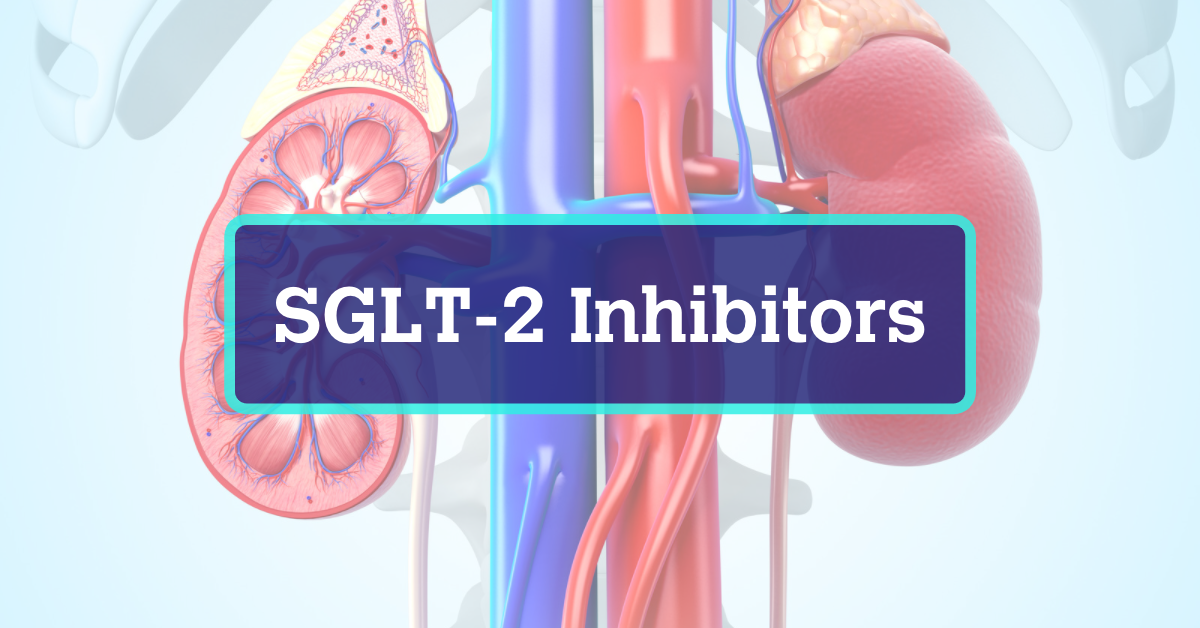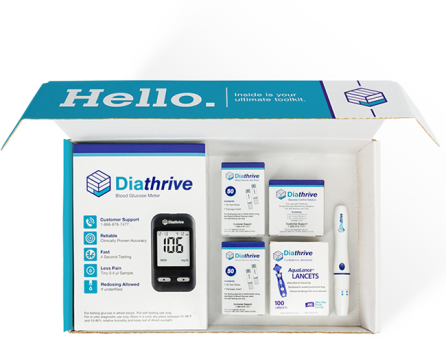
Here’s what to know when it comes to the basics of a SGLT2 inhibitor, why it is used to help manage type 2 diabetes, how it works, and potential side effects.
There's lots to learn when you are newly diagnosed with diabetes, especially when it comes to self-care and treatment options. Type 2 diabetes, specifically, has several options that can be implemented for successful diabetes management. One of the most common is a SGLT-2 inhibitory. Here's what you need to know.
Quick Diabetes Basics
Diabetes happens when your body cannot efficiently convert glucose into energy, which can cause some serious turbulence for your everyday health. Type 1 and type 2 diabetes are different conditions, but have the same result – a buildup of excess glucose in your blood.
Let’s quickly review how glucose works in your body and talk about the difference between type 1 and type 2 diabetes.
When you eat, your body starts working to process food into glucose and other nutrients your body needs. Enzymes in your stomach break down food so that it can be absorbed by your intestine. Nutrients, including glucose, are absorbed from your intestine into your bloodstream. Insulin, produced by the beta cells in your pancreas, works to allow glucose into your cells for fuel. Insulin works sort of like a key unlocking your cells so they can use glucose for fuel.
-
Type 1 Diabetes: Type 1 diabetes is an autoimmune disorder and is believed to have a strong genetic connection. With type 1 diabetes, your body mistakes its own healthy cells for foreign invaders (the same way your body reacts to illnesses). Specifically, your body considers the beta cells in your pancreas as foreign and attacks and destroys them. When your pancreas does not produce insulin, your cells don’t have the glucose they need for fuel. Because your cells cannot access the glucose in your blood, blood glucose levels rise, often rapidly.
-
Type 2 Diabetes: With type 2 diabetes, your body most likely still produces insulin, but doesn’t produce enough or doesn’t use it efficiently. Unlike type 1 diabetes, beta cells are not destroyed (at least in the beginning), but they become exhausted through creating more and more insulin that the body is not using efficiently. Eventually, your body may lose the ability to make insulin. Like type 1 diabetes, type 2 diabetes results in rising blood glucose levels.
Although both type 1 and type 2 diabetes cause high blood glucose, the treatments for type 1 and type 2 diabetes are different.
If you have been diagnosed with type 1 diabetes, you need to take insulin every day so that your body can use the glucose in your blood to fuel your cells.
Treatment of type 2 diabetes is different from person to person. Some people need insulin, some need different medications, and others are able to manage blood sugar through changes in eating habits and exercise. The most common medication used in type 2 diabetes treatment is metformin. Metformin works by reducing glucose production in the liver, which helps maintain lower blood sugar. Other medications include sulfonylureas that help your body make more insulin, and thiazolidinediones that make your body more sensitive to insulin. Your doctor will decide what is best for you.
Sometimes people living with type 2 diabetes need additional help managing their blood glucose levels. This is what brings us to the discussion of SGLT2.
SGLT2 Inhibitors
SGLT2 is an abbreviation for sodium glucose co-transporter 2 (SGLT2), and inhibitor just means one thing that stops another thing from happening.
SGLT2 Inhibitors are a class of drugs sometimes prescribed for people living with type 2 diabetes who have problems managing their blood glucose, and have high A1c levels. SGLT2 inhibitors have not yet been proven safe or effective in the treatment of type 1 diabetes.
SGLT2 inhibitors are most often used when a person’s current treatment for type 2 diabetes is not effective. SGLT2 inhibitors help lower blood sugar by increasing the amount of glucose your body is able to dispose of in urine. Your kidneys filter out excess glucose from your blood, playing an important role in maintaining proper blood sugar levels. Blood sugar is also naturally reabsorbed from the kidneys back into the bloodstream.
SGLT2 Inhibitors work by blocking this reabsorption, which increases the amount of glucose in urine, helping to reduce the amount of glucose in your blood.
SGT2 inhibitors may also reduce the risk of kidney and heart disease, lower blood pressure, and reduced body weight.
There are currently three types of SGLT2 inhibitors available:
-
Canagliflozin (trade name Invokana)
-
Dapagliflozin (trade name Farxiga)
-
Empagliflozin (trade name Jardiance)
Generally, SGLT2 inhibitors are taken once a day before your first meal and are most often used in conjunction with other diabetes medicines.
Other Benefits of SGLT2 Inhibitors
Studies have suggested that SGLT2 inhibitors may help protect the heart, and lower the risk of worsening kidney function for people living with chronic kidney disease. This is good news because many people living with diabetes have a higher risk for heart and kidney disease. In fact, heart disease is the leading cause of death for people with diabetes.
The American Diabetes Association's guidelines actually recommend SGLT2 inhibitors for people living with diabetes who also have been diagnosed or are at high risk for heart disease. Recent clinical trials have shown that SGLT2 inhibitors can reduce the incidence of cardiovascular death and heart failure, even in people who are not living with diabetes. It is not clear how SGLT2 provides the beneficial outcomes, but it may be related to reduced blood pressure, reduction in inflammation overall, and other factors.
SGLT2 inhibitors appear to slow down development of kidney problems, and also may help people with chronic kidney disease by lowering the risk of worsening kidney function, risk of dialysis, transplantation and death. It has been shown that these medications cause a reduction in albuminuria, which is a sign of kidney disease.
Potential Side Effects
Since SGLT2 inhibitors are relatively new to the market, they are often used after use of other medications is unsuccessful. This is because other medications that have been on the market for some time have a longer safety record and are less expensive than SGLT2 inhibitors. SGLT2 inhibitors are a good option when metformin has not been successful in treating type 2 diabetes, especially when weight reduction is also desired.
As with all medication, SGLT2 inhibitors can have side effects, some that are serious.
Side effects can include:
-
Urinary tract and yeast infections. Increased glucose in urine makes people more susceptible to yeast infections and urinary tract infections. This is because excess sugar in your urine creates an environment for bacteria and yeast to grow in your urinary tract or genital area.
-
Low blood pressure. SGLT2 inhibitors can lead to low blood pressure, so if your blood pressure is already low, your doctor may not prescribe this medicine. If you have high blood pressure, SGLT2 inhibitors can help reduce it.
-
Ketoacidosis. In 2015, the U.S. Food and Drug Administration released a warning that SGLT2 inhibitors can increase the risk of diabetic ketoacidosis (DKA), particularly in the perioperative period (the time period of a surgical procedure). Ketoacidosis happens when your body doesn’t have enough insulin and starts making energy from fat since you are unable to use the glucose in your system. Ketones are an acid created by your body when it burns fat instead of glucose for fuel. Problems arise when ketones build up in your system. Untreated, DKA can be life threatening.
-
Bacterial infections in the pelvic floor. Although extremely rare, SGLT2 inhibitors can cause a life-threatening infection in tissue of the pelvic floor called necrotizing fasciitis of the perineum. This condition happens when bacteria infect the underlying layers of skin in the genital area. People taking SGLT2 inhibitors who develop tenderness, redness, or swelling in their genital area should seek immediate medical attention.
Your health care provider will weigh the benefits and risks of all medications before developing a diabetes management plan for you. Always discuss benefits and risks with your healthcare provider.
SGLT2 Inhibitors and A1c
A1c (also known as HbA1c) measures glycated hemoglobin in your system. Hemoglobin is a protein that carries oxygen to your cells. Excess glucose in your blood attaches to hemoglobin while it is doing its work. The longer your blood sugar levels run high, the more glucose will attach, showing up in an HbA1c blood test.
The results of an A1c test can be translated into your average blood sugar level over the past three months. Blood sugar changes from hour to hour and day to day, so daily blood sugar tests cannot predict your overall blood glucose levels over time. The A1c test solves this problem by giving you a better idea of your blood sugar over time. Normal A1c levels range from 4.5 to 5.6 percent for someone who doesn’t have diabetes.
An A1c level over 6.4 percent on two separate tests prior to diagnosis indicates you have diabetes, or if you've already been diagnosed, that your current diabetes treatments may not be working. People living with diabetes who have abnormal levels of A1c despite following their diabetes management plan may benefit from SGLT2 inhibitors.
Wrapping It Up
In summary, SGLT2 inhibitors can help people living with type 2 diabetes better manage blood glucose levels.
SGLT2 inhibitors are used most often by people who have problems with their blood glucose and have high A1c levels. SGLT2 inhibitors can also have beneficial effects for people who have heart or kidney disease.
As with all medications, SGLT2 inhibitors can have unwanted side effects. Discuss the advantages and potential side effects of all medications with your doctor.
Sources:
SGLT2 Inhibitors - The Johns Hopkins Patient Guide to Diabetes (hopkinsdiabetesinfo.org)
Sodium-glucose Cotransporter-2 (SGLT2) Inhibitors | FDA




